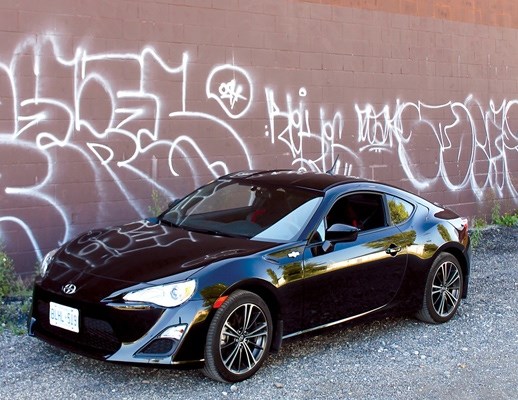Scion is dead.
In an official statement this week, Toyota indicated that their youth-oriented subbrand would be "transitioning back to Toyota." In other words, they'll be chiselling off the badges down at the dock: the experiment is officially over.
It's hard not to be gleeful over the news. There are no dealerships to fold up, nobody to fire. The rolling up of Scion as an offshoot of Toyota is nearly without casualty. After 13 years of slow sales and stale growth in the United States, and five similarly hohum years in Canada, it was high time for Scion to take a hike.
But maybe this is a surprise to you, as you've heard cars like the FR-S heaped with praise. It's true, some of Scion's products were pretty good, but that wasn't the problem.
Take the iM hatchback, the most recent Scion product I drove. After having a chance to punt the little car around Calgary, I found it full of features to recommend. It was reasonably stylish. It had good storage. You could get it with a manual option if you wanted.
And, best of all, it was actually a Toyota product. That means decent reliability, good resale, and a relatively hassle-free dealership experience. Maybe the suspension was a tad on the harsh side, but the iM made for a strong contender. My only real issue with the car was the Scion badge up front.
And now, praise be, you'll be able to get an iM without the Scion badging. If you're lucky, they'll even bring it back as the Matrix again.
For people who loved the Corolla but wanted hatchback flexibility, this is excellent news. Because of Scion's single-model pricing program, the iM's sport-tuned suspension was a little too firm for mature buyers, many of whom liked the Matrix for its practical side. At the product launch, I wondered aloud if the iM wouldn't do well as a softened Toyota product, but the parent company didn't want the overlap.
But now the iM will be back as a Toyota, and maybe they'll find room to offer it with hubcaps and soft suspension for baby boomers and big wheels and big stereo for the younger crowd. More choice is never a bad thing.
The idea behind Scion wasn't a bad one. Toyota is not known as an exciting brand, offering instead reliability and resale. Thus, the brand found itself skewing older in buyer age, and wondered what they might do to capture the youth market. If Lexus was the luxury competitor, then surely a brand focused on youth would do just as well.
Initially, Scion did pretty well. The homely little xB did well in the United States, being cheap, fun-to-drive, and practical. Scion's financing was pretty straightforward, with good deals for students. And yet, as time dragged on, sales flagged, then stalled.
Among other things, the problem was one of perception. The mythical youth buyer is largely a figment of some marketer's imagination: you know who doesn't have any money? Young people. They're too busy trying to break into the housing market, or spending it on having an actual lifestyle to be worried about lifestyle brands. If there's a presumption to luxury, then the luxury brands are leasing for relatively affordable rates. If there's a desire for stability, then namebrand safety is looked for.
So, if you're in your 20s and looking for your first new car, what do you do? You talk to your parents, and maybe they help you out with the down payment. Tell them you're buying a Scion and Dad scratches his head. Tell them you think a four-cylinder Toyota would do the trick and Mom nods approvingly. Then they buy you a 15-year-old Corolla instead.
The thing is, regardless of age, consumers all want the same things from their automobile at a base level. They want to not lose money on it. They want it to get them where they're going. They don't want to have to worry too much about maintenance and breakdowns. These are all Toyota strengths, whether in fact, or just in consumer perception. Toyota has worked hard to trumpet its reputation for reliability, so why is it wasting its time trying to create a whole new brand to support.
And it's not like Toyota's never done anything cool. The MR2. The Supra. The Celica. Heck, look at the success of the Toyota Tacoma in the youth market to see how to do branding right. Every shin-scraped downhill mountain biker would trade their third-best bike to get into a new Tacoma, even though the current truck doesn't have youth-positioned advertising.
The Tacoma is durable, simple, and rugged. People who spend a lot of their time doing stuff outdoors like those attributes. It'll please the first owner, the second owner, and its scraggly-bearded third owner. That's how these things work.
Furthermore, if you want Joe Q. Public to be OK with buying a Camry when he finally settles down, you might as well get him into a youthoriented Toyota product now. Sell him the Toyota GT86 that the rest of the world gets (we call it the Scion FR-S), and he'll glance on the badge on the front and remember the days when he still had time to go to drift competitions. Then he'll bring home the RAV4 brochure when there's a sonogram pinned to the fridge.
Don't you get it, Toyota?
You're already cool, you don't need the fake cool of some hip-hop infused marketing schtick. Canadians have been relying on you to get around, racing, rallying, hauling their outdoor gear, and laying down quarter-mile times in their Fast and Furious tribute Supras for years.
So, goodbye to Scion. Farewell, sweet prince. It was a nice idea, but turns out we all just wanted a Toyota in the first place.
mcaleeronwheels@gmail. com



